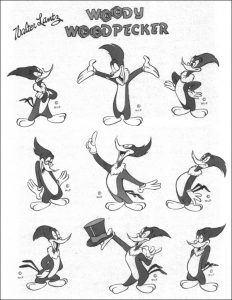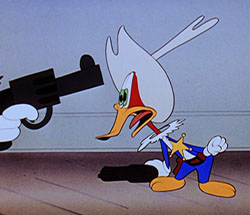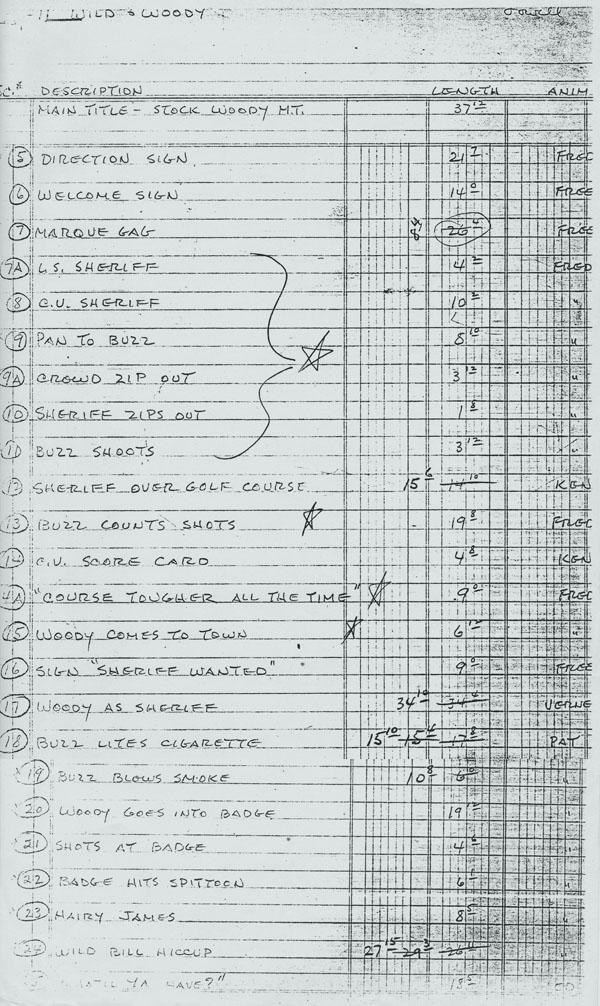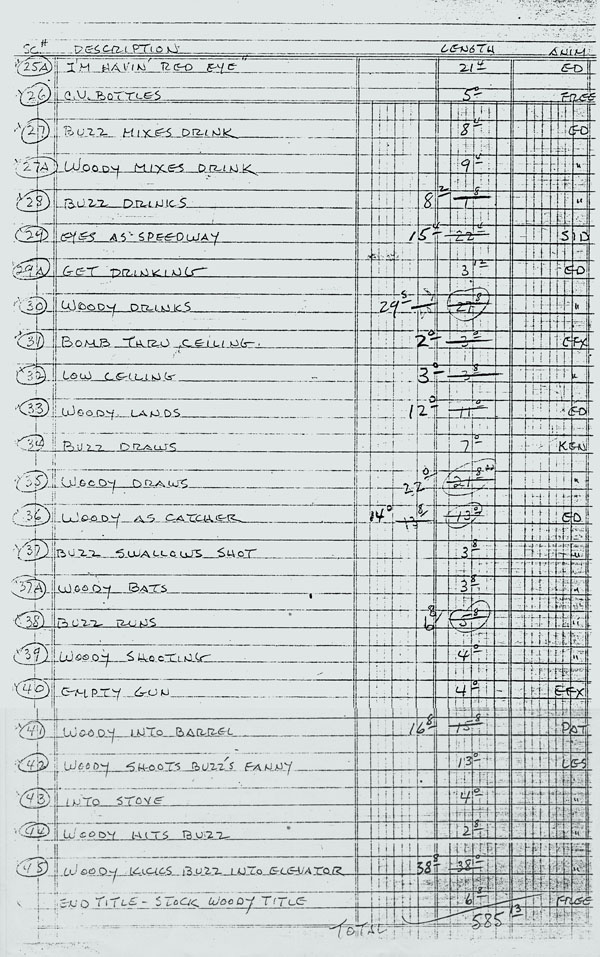
This cartoon was already discussed back in February 2014 – Jerry wrote the text and I supplied the draft, from Mark Kauslers collection – but I have much more to say about this great Woody Woodpecker entry.
 When Dick Lundys Wild and Woody was produced in Walter Lantz’s studio, under the distribution of United Artists, the cartoons possessed a slick, appealing style, which suggested a blend of Disney and MGMs animated films during the late 1940s. The connection became evident in the hiring of former Disney animator Fred Moore and Ed Love, previously an animator in Tex Avery’s unit at MGM. Heck Allen also worked with Avery at MGM as a story-man, and is co-credited with Ben Hardaway on this cartoon. While the story plays much like a succinct hero/outlaw Western, the help of other artists such as Ken OBrien, Les Kline and Pat Matthews, keeps it buoyed with a cornucopia of brilliant character animation. (Verne Harding is only given one shot in the film.)
When Dick Lundys Wild and Woody was produced in Walter Lantz’s studio, under the distribution of United Artists, the cartoons possessed a slick, appealing style, which suggested a blend of Disney and MGMs animated films during the late 1940s. The connection became evident in the hiring of former Disney animator Fred Moore and Ed Love, previously an animator in Tex Avery’s unit at MGM. Heck Allen also worked with Avery at MGM as a story-man, and is co-credited with Ben Hardaway on this cartoon. While the story plays much like a succinct hero/outlaw Western, the help of other artists such as Ken OBrien, Les Kline and Pat Matthews, keeps it buoyed with a cornucopia of brilliant character animation. (Verne Harding is only given one shot in the film.)
The cartoon’s recording session with Pinto Colvig occurred on July 23, 1947, as did the gravelly Lionel Stander’s work as the merciless outlaw Buzz Buzzard. It is safe to assume Ben Hardaway provided the voice for Woody Woodpecker on this same date. (Eddie Marrs dialogue track for Buck Beaver in Scrappy Birthday was also recorded during this session.)
Pinto Colvig, who worked for Disney and MGM, lends his voice for characters and effects in the film; he is the wheezy sheriff in the opening scenes, Wild Bill Hiccup and an elevator operator whose identity should be saved to avoid spoilers. Earlier in this career, Colvig worked for Lantz in the early 30s as an animator and in early 40s as a voice actor.
 According to documentation housed in the UCLA Walter Lantz Archives, the murmuring crowd before the newly-elected sheriff is provided by Hardaway, Heck Allen and radio actor Jack Mather, the regular voice for Wally Walrus. Grace Stafford – Lantz’s wife and permanent voice for Woody Woodpecker starting in the 1950s – recorded the dialogue track for another elevator operator at the end of the film.
According to documentation housed in the UCLA Walter Lantz Archives, the murmuring crowd before the newly-elected sheriff is provided by Hardaway, Heck Allen and radio actor Jack Mather, the regular voice for Wally Walrus. Grace Stafford – Lantz’s wife and permanent voice for Woody Woodpecker starting in the 1950s – recorded the dialogue track for another elevator operator at the end of the film.
Wild and Woody is primarily cast by sequence, and each artist displays nuanced, flowing movement. Fred Moore animates the introduction of Woody traveling by horseback, Buzz Buzzard and the law enforcement of Rigor Mortis, Arizona. Moore’s scenes use a few held poses when characters speak their dialogue. As the menace is established in the opening sequences, Buzz takes two shots too many as the newly elected sheriff nearly escapes and is slain, as evidenced in his score card. Moore also animates Woody riding into town before he accepts the offer to become the new sheriff.
Verne Harding animates Woody out of the law enforcement office, adorned with a badge and six-shooters at his grip, with earnest readiness to rid the town of Buzz Buzzard. As Woody states he will tear out his gizzard, he finds himself standing face-to-face with Buzz himself, rendering him a smaller and anxious sheriff. Pat Matthews handles Buzz as a true ornery foe, as he prepares a cigarette into his revolver barrel, shoots it into his mouth and inhales with one puff. Woody takes refuge inside the Pigs Foot Saloon, and Buzzin a great piece of animationenters in between the swinging doors. Wild Bill Hiccup’s appearance before Buzz’s entrance is superbly animated, as well.
 Ed Love animates the Woody and Buzz each downing shots of Red-Eye liquor. Both recoil from the horrid drink with fiery results; Woody assumes the shape of a rocket and crashes through the ceiling, echoing a similar gag in Tex Avery’s The Shooting of Dan McGoo (1945), which Love also worked on. Love also animates much of the duel between the two, with some sequences handled by Ken O’Brien and Pat Matthews. Les Kline is given the last scenes of the film, from Woody blasting Buzz’s tail feathers with a large gun to Buzz being kicked into an elevator. Kline’s drawing is more balloony in his scenes, but his work is still impressive here.
Ed Love animates the Woody and Buzz each downing shots of Red-Eye liquor. Both recoil from the horrid drink with fiery results; Woody assumes the shape of a rocket and crashes through the ceiling, echoing a similar gag in Tex Avery’s The Shooting of Dan McGoo (1945), which Love also worked on. Love also animates much of the duel between the two, with some sequences handled by Ken O’Brien and Pat Matthews. Les Kline is given the last scenes of the film, from Woody blasting Buzz’s tail feathers with a large gun to Buzz being kicked into an elevator. Kline’s drawing is more balloony in his scenes, but his work is still impressive here.
Wild and Woody was released on December 30, 1948, at which time the Lantz studio shut its doors, before resuming production around 1950. Judging by the production order of the Lantz cartoons, Wild and Woody was the final Woody Woodpecker cartoon with a full crew of animators during the 1940s. The last two in production – and final releases – were Scrappy Birthday and Droolers Delight; the latter film entirely animated by Ed Love.
Admittedly, requests for animator drafts for the last two films from the UCLA Walter Lantz Archives proved fruitless – the scene descriptions were written out but the animators assigned to them were empty. Its probable that because the studio was closing, whoever was in charge of filling out the forms didnt care to complete them. (However, its more perplexing in the case of another draft I requested, the cult classic Apple Andy, released two years earlier, is missing animator assignments, as well.) I might do animator breakdowns of Apple Andy and Scrappy Birthday based on educated guesswork, but theres no definite answer.
Enjoy the show, pardners!


(Thanks to Mark Kausler, Keith Scott, Frank Young, Tom Klein and Heather Wilbur for their help.)


 DEVON BAXTER is a film restoration artist, video editor, and animation researcher/writer currently residing in Pennsylvania. He also hosts a
DEVON BAXTER is a film restoration artist, video editor, and animation researcher/writer currently residing in Pennsylvania. He also hosts a 



















































































It’s safe to assume there might be more “reduxs” in the future?..
Sorry to say, but no.
Jack Mather was Wally Walrus??? Gee. I remember him from the 60’s when his voice beckoned you to “Come on in…. it’s Art Linkletter’s House Party!”
Art Linkletter’s announcer was Jack Slattery. Slattery also announced the radio pilot disc of “You Bet Your Life”–which used an audience “borrowed” fro “Art Linkletter’s House Party”
Thanks for the voice notes. I had no idea Colvig worked on this cartoon. It sounds like him as the gulping Woody in the bar. Stander does an outstanding job on this. Calker’s score is excellent. And Moore’s work at the beginning is some of the nicest animation I’ve seen in a Lantz cartoon. I’d love to know who Lantz’s layout artist was.
What a shame the studio closed and this fine line-up of talent dispersed.
What is the meaning of the brackets and stars on the first page of the draft?
Freddie Moore was a perfect fit for 40s Woody cartoons!
This early period of WOODY WOODPECKER still remains my favorite, for the wild poses alone; I can recall some of the frenetic action in some of tehse films, but I appreciate the breakdowns here as there is a lot I don’t completely recall, and it is funny you should say that the alcohol reaction from Woody is similar to a gag in “THE SHOOTING OF DAN MCGOO”, because I was thinking the same thing when I was reacquainted with the DROOPY cartoon, thanks to its release on laserdisk and DVD.
Colvig also voiced for WB,as well.
And for Paramount for the Fleschier Studios as Bluto in several Popeye cartoons,,Gabby in Gulliver’s Travels and in Gabby’s own series and Mr Creeper in Mr. Bug Goes To Town/Hoppity Goes to Town.
It is a shame the studio had to shut down at this point, because not only did Lantz have a group of high-level animators working for him, the studio had finally found a foil for Woody that could make the stories work in a way they couldn’t in the past. The nastiness in action and voice of Stadler’s Buzz allows Woody to go in full-bore on him and completely have the audience’s support, in a way tormenting Wally Walrus or the guest bad guy of the moment didn’t.
The 1950s budget cuts that went through all studios would have eventually cut the quality of the Lantz product. But it would have been nice if the decline could have waited until the mid-50s, instead of being forced by the shutdown and arriving immediately after the studio reopened.
The fact that Grace Stafford Lantz did an incidental voice makes me wonder.
Is it possible that the story of her getting the part of Woody Woodpecker through a blind audition is just that–a story?